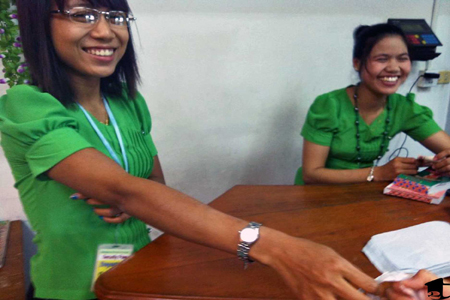The Body is The First Basis of a Person's Identity
Touch produces one of the most sensitive of actions or responses. It can be sensuous, friendly, assuring or threatening. The use of various parts of the body conveys messages, obvious or hidden. So be careful about what you do to another's body or to your own. What follows will help you to understand what the body says and to avoid bad language when taking Myanmar trips.

Don't Touch Anybody on The Head
The head may or may not be considered sacred but it is the most esteemed part of the body. To be touched on the head is considered to be subject to aggression and a call for submission. Outside of a unique situation where such touching might be relevant, nobody would willingly accept it. It might be just the act to raise the hackles. So the first rule of grammar in body language: don’t touch anybody on the head.
Don't Pat Anybody on The Back
Patting somebody on the back is taken, in some cultures, as a sign of appreciation, encouragement or sympathy. But it can also be taken as a sign of excessive intimacy or condescension. Appreciation, encouragement or sympathy can be expressed vocally and will be accepted as such. Don’t take the risk of being misunderstood by patting somebody on the back.
Don't Touch a Woman On Any Part of The Body
Myanmar women place much value on modesty. To be touched on any part of the body by any man, especially a foreigner, is considered a violation of that modesty. So don't touch a Myanmar woman, friend or otherwise, on any part of her body in public.
How about shaking hands? A Myanmar woman would prefer not to do that. She would prefer to just smile and nod. But if in the situation a refusal would be considered unsociable of her she would accept your hand for a quick touch.
Don't Point a Finger Straight In The Face
You may be used to emphasizing a point or trying to make it clear by pointing a forefinger straight in the face of a person. Here, such a gesture would be taken as an accusation, sign of contempt or aggression. Avoid misunderstanding by never pointing a finger in the face of a person.
Don't Step Over Any Part of a Person
People don’t like being stepped over. Stepping over a person's stretched out legs when sitting or any part of the body when lying down is resented.
In a bus, train or aircraft or in a crowded place any- where, if you have to move and it is impossible without stepping over someone ask permission by a smile, nod or gesture. The stretched-out legs will be gathered in or the person lying down will sit up or give you permission to step over the lower part of the body.
Seek Permission on Retrieving an Article Above a Person's Head
In an aircraft, train or long-distance bus, the occasion may arise to retrieve an article from the overhead rack. Ask permission of the person in the seat below. When you retrieve your bag, after receiving permission, make sure you don't drop it on the person's head.
Keep The Feet on The Ground
You may be the kind of person who sits down and immediately crosses the legs or rests a foot or feet upon the backrest of the seat in front in an aircraft or train, or you press your feet against the back of that seat. You shouldn't do that. The feet or the shoes on the feet are not the cleanest part of you and nobody likes the vision of a pair of shoes in the corner of the eyes or of something hard pressing in the back. Keep your feet always on the ground where they belong.
Bend a Bit When Crossing Close In Front of a Person
At a charity, a party or a show, bend a bit when crossing close in front of a person. This is not a bow but an act of courtesy. At a show, you may still block the view of the person as you pass, but the slight bend will be understood as a request for excuse or pardon. If you say gadaw as you pass, it will be most appreciated.


Interesting. Can you please tell me: How do you move your head in Myanmar when expressing a yes and a no?
Hi Stig, nod and shake your head to express a yes and a no